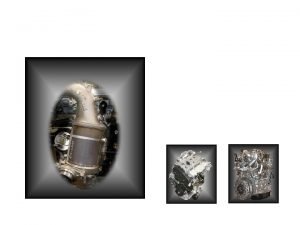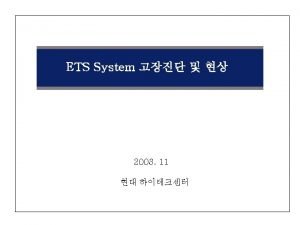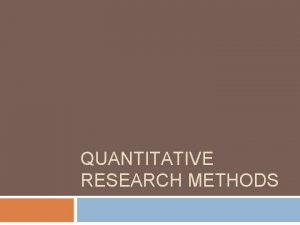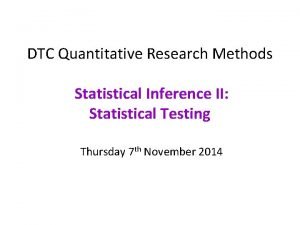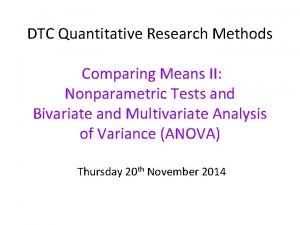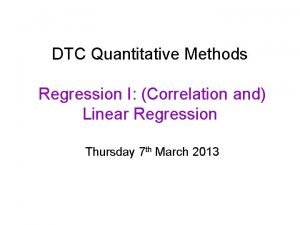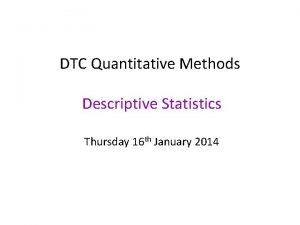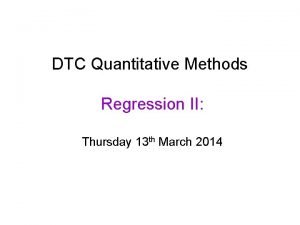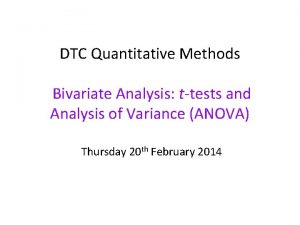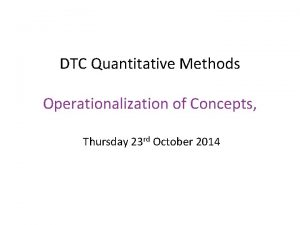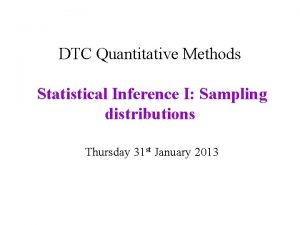DTC Quantitative Methods Survey Research DesignSampling Mostly a










































- Slides: 42

DTC Quantitative Methods Survey Research Design/Sampling (Mostly a hangover from Week 1…) Thursday 16 th January 2014

Thinking about what you’re researching: Case, Population, Sample • Population – all theoretically-relevant cases (e. g. ‘Tottenham supporters’). This is also often referred to as the target population. • This may differ from the study population, which is all of theoretically-relevant cases which are actually available to be studied (e. g. ‘all Tottenham club members or season ticket holders’).

Sometimes you can study all possible cases (the total population that you are interested in) For example: – Post WW 2 UK Prime Ministers – Homeless people using a particular shelter on Christmas Day 2013 – National football teams in the 2014 World Cup – Secondary schools in Coventry

Often you cannot research the whole population because it is too big and to do so would be too costly, too time consuming, or impossible. For example, if your ‘population’ is: – Voters in the UK since WW 2 – All the homeless people in the UK on Christmas Day 2013 – Club and National Football teams involved in cup competitions in 2014 – Secondary schools in the UK. On these occasions you need to select some cases to study. Selecting cases from the total (study) population is called sampling.

How you sample depends (among other things) on some linked issues: • What you are especially interested in (what you want to find out) • The frequency with which what you are interested in occurs in the population • The size/complexity of the population • What research methods you are going to use • How many cases you want (or have the resources and/or time) to study

Sampling error or bias? • A parameter is a quantity relating to a given variable for a population (e. g. the average (mean) adult income in the UK). • When researchers generalize from a sample they use sample observations to estimate population parameters. • The sampling error for a given sample design is the degree of error that is to be expected in making these estimations. • So the parameter estimates generated by quantitative research are equal to the population parameters, plus a certain amount of sampling error, plus any bias arising from the data ‘collection’ process.

Probability and non-probability sampling Probability samples (‘Random samples’) A probability sample has a mathematical relationship to the (study) population: we can work out mathematically what the likelihood (probability) is of the results found for the sample being within a given ‘distance’ of what would be found for the whole population (if we were able to examine the whole population!) Such a sample allows us to make inferences about the population as a whole, based on the sample results. Non-probability samples Formally, these do not allow us to make inferences about the population as a whole. However, there are often pragmatic reasons for their use, and, despite this lack of statistical legitimacy, inferential statistics are often generated (and published!)

• Random sampling: Each element in the population has a known, non-zero chance of selection. ‘Tables’ or ‘lists’ of random numbers are often used (in print form or generated by a computer, e. g. in SPSS). • Sampling frame: A list of every element/case in the population from which a probability sample can be selected. In practice, sampling frames may not include every element. It is the researcher’s job to assess the extent (and nature) of any omissions and, if possible, to correct them.

Types of Non-probability sampling: 1. Reliance on available subjects: • Literally choosing people because they are available (e. g. approaching the first five people you see outside the library) • Only justified if less problematic sampling methods are not possible. • Researchers must exercise considerable caution in generalizing from their data when this method is used.

Types of Non-probability sampling: 2. Purposive or judgmental sampling • Selecting a sample based on knowledge of a population, its elements, and the purpose of the study. Selecting people who would be ‘good’ informants (individually/collectively). • Used when field researchers are interested in studying cases that do not fit into regular patterns of attitudes and behaviours (i. e. when researching ‘deviance’). • Relies totally on the researcher’s prior ability to determine ‘suitable’ subjects.

Types of Non-probability sampling: 3. Snowball sampling • Researcher collects data on members of the target population s/he can access, and uses them to help locate other members of the population. • May be appropriate when members of a population are difficult to locate (and/or access). • By definition, respondents who are located by snowball sampling will be connected to other respondents, thus respondents are more likely to share similarities with each other than with other members of the population.

Types of Non-probability sampling: 4. Quota sampling • Begin with a matrix of the population (e. g. assuming it is 50% female and 9% minority ethnic, with a given age structure). • Data is collected from people matching the defining characteristics of each cell within the matrix. • Each cell is assigned a weight matching its proportion of the population (e. g. if you were going to sample 1, 000 people, you would want 500 of them to be female, and hence 45 to be minority ethnic women). • The data thus provide a representation of the population. • However, the data may not represent the population well in terms of criteria that were not used to define the initial matrix. • And, crucially, the selection process may be biased.

The logic of probability sampling • Representativeness: A sample is representative of the population from which it is selected to the extent that it has the same aggregate characteristics (e. g. same percentage of women, of immigrants, of poor and rich people…) • EPSEM (Equal Probability of Selection Method): Every member of the population has the same chance of being selected for the sample.

A Population of 100

Types of probability sampling: 1. Simple Random Sample • Feasible only with the simplest sort of sampling frame (a comprehensive one). • The researcher enumerates the sampling frame, and randomly selects people. • Despite being the ‘purist’ type of random sample, in practice it is rarely used.

A Simple Random Sample

Types of probability sampling: 2. Systematic Random Sample • Uses a random starting point, with every kth element selected (e. g. if you wanted to select 1, 000 people out of 10, 000 you’d select every 10 th person: such as the 3 rd, 13 th, 23 rd…). • The arrangement of cases in the list can affect representativeness (e. g. if k is even, when sampling pages from a book with chapters starting on odd-numbered pages).

Types of probability sampling: 3. Stratified sampling • Rather than selecting a sample from the overall population, the researcher selects cases from homogeneous subsets of the population (e. g. random sampling from a set of undergraduates, and from a set of postgraduates). • This ensures that key sub-populations are represented adequately within the sample. • A greater degree of representativeness in the results thus tends to be achieved, since the (typical) quantity of sampling error is reduced.

A Stratified, Systematic Sample with a Random Start

Types of probability sampling: 4. Multi-stage Sampling • This is often used when it is not possible or practical to create a list containing all the elements within the target population. • It involves the repetition of two basic steps: creating lists of sampling units and sampling from them. • It can be highly efficient but less accurate.

Example of Multi-stage Sampling Coventry residents 1. 2. 3. 4. 5. 6. 7. 8. Make a list of all neighbourhoods in Coventry Randomly select (sample) 5 neighbourhoods Make a list of all streets in each selected neighbourhood Randomly select (sample) 2 streets in each neighbourhood Make a list of all addresses on each selected street Select every house/flat [‘Cluster’ sampling!] Make a list of all residents in each selected house/flat Randomly select (sample) one person to interview.

Types of probability sampling: 5. Probability Proportional to Size (PPS) sampling • A sophisticated form of multi-stage sampling. • It is used in many large-scale surveys. • Sampling units are selected with a probability proportional to their size (e. g. in a survey where the primary sampling units (PSUs) were cities, a city 10 times larger than another would be 10 times more likely to be selected in the first stage of sampling).

Note • The sampling strategies used in real projects often combine elements of multi-stage sampling and elements of stratification. • See, for example, the discussion of Peter Townsend’s poverty survey on p 120 of Buckingham and Saunders, 2004. • See also Rafferty, A. 2009. Introduction to Complex Sample Design in UK Government Surveys for summaries of the sample designs of various major UK surveys http: //www. esds. ac. uk/government/docs/complexsampledesign. doc

Sample size The sample size that is needed depends upon: • The heterogeneity of the population: the more heterogeneous, the bigger the sample needed • The number of relevant sub-groups: the more sub-groups, the bigger the sample needed • The frequency of a phenomenon that you are trying to detect: the closer to 50% (of the time) that it occurs, the bigger the sample needed • How accurately you want your sample statistics to reflect the population: the greater accuracy that is required, the bigger the sample needed. • How confident you want to be about your results!

Other considerations when you are thinking about sample size • The response rate – if you think that a lot of people will not respond, you need to start off by sampling a larger number of people. • Form of analysis – some forms of statistical analysis require a larger number of cases than others. If you plan on using one of these you will need to ensure that you’ve got enough cases. Generally (given a choice): Bigger is better! (hence the sample size often reflects costs/resources. )

Weighting: A commonly-needed adjustment • This is used when a particular group has been ‘over-sampled’ (or ‘under-sampled’). This occurs in ‘disproportionate sampling’. • It assigns some cases more weight than others on the basis of the different probabilities of selection each case had. • The appropriate approach is to give each case a weight that is (proportional to) the inverse of that case’s selection probability.

Weighting example • I have a population of 10, 000 university students that includes 10% minority ethnic students. • I want to sample 100 people and to compare ‘white’ and minority ethnic respondents. • If I sample randomly I will probably get only about 10 minority ethnic respondents. This won’t give me much of a basis for a comparison. • So I stratify my sample and sample 50/1000 minority ethnic students, giving a probability of selection of. 05 • . . . and 50/9, 000 ‘white’ students, giving a probability of. 0056 • We now have 50 ‘white’ and 50 minority ethnic respondents – this is useful because it provides more balanced information about the two sub-populations. • However, it now looks from the sample as if the population is 50% minority ethnic, which is not the case. • To ‘re-weight’ the responses to make them represent the composition of the ‘real’ population I can multiply each minority ethnic respondent by the inverse of their chance of selection (1000/50 = 20) and each ‘white’ respondent by the inverse of their chance (9000/50 = 180). • These weights give a sample size that is 100 times too large (10, 000/100), so dividing by 100 gives final weights of 0. 2 and 1. 8.

Content Analysis Method of transforming symbolic content of a document (such as words or images) from a qualitative unsystematic form into a quantitative systematic form. See Bryman, 2008, Ch. 12

Possible Units of Analysis for Content Analysis …but a unit of analysis may also be: a film, a scene, a TV episode, a wall (containing graffiti), a rubbish bin, a politician’s speech, a web-site, or a blog posting…

Comparative-Historical Research • Much comparative-historical research does not use statistics. • However if you are looking at change over time or are comparing different countries or regions there a large number of statistics that can be used: • Macro-level secondary statistics – e. g. World Bank “development indicators” i. e. mortalitity rates; televisions per 1000 population; Literacy rates. Or “OECD Main Economic Indicators” – i. e. foreign direct investment; GDP; GNP… etc. [See the Library Statistics Workbook that is linked to the module web page; this is of value both in terms of accessing international data and statistical sources generally] • Primary statistics – these are datasets that you construct for yourself from historical and comparative research. They may document anything from the strength and political composition of particular trade unions in a particular time and place; to landholding patterns in different regions as described by local taxrecords; to speeches made by Vice-Chancellors of UK universities at public forums over the last century… To conduct quantitative analysis of primary historical research it just needs to be systematically coded.

Sampling Comparative-Historical Events • If you are going to use comparative-historical data to create a dataset it is important to think about whether you have data from the entire population of events that you are interested in (i. e. every strike that occurred in the UK between 1990 and 2000), or whether you are focusing on a subset (thirty strikes that occurred in the UK between 1990 and 2000). • If you present statistical information for a subset of events you are sampling and the same issues of occur as any other time that you sample data: your findings are only statistically generalisable if the sampling is random (or if each event has a known - typically equal probability of selection into the subset). • On the other hand, there are often substantive reasons to choose specific “important” events to be part of your subset (i. e. largescale strikes that involved media campaigns). This is legitimate and statistics gleaned from these may be interesting and informative. However they are not statistically generalisable to all events (i. e. strikes generally) and so inferential statistics are not appropriate.

Observation(al) studies • Observation is not just the preserve of qualitative methods. Quantitative methods can be applied where structured or systematic observation is carried out. • Like qualitative observation studies (and surveys), this involves cross-sectional data (we can only observe the present). • Unlike qualitative observation, structured or systematic observation is not inductive but requires the prior determination of what to observe (although this may be suggested by initial unstructured observations). See Pole and Lampard, 2002, Ch. 4.

The observation schedule • To produce quantitative data an observation schedule or coding scheme is required. • This describes what is to be observed and how what is observed should be coded. • For example, if I were observing in the Library Café and was interested in interactions between students and the staff working at the cash-registers I could code each student’s behaviour in the following way: 1. 2. 3. 4. No conversation, no eye contact, no smile Eye contact and/or smile, no conversation Conversation, only as required by the transaction Conversation as required by the transaction and polite thanks. 5. Conversation that goes beyond transaction and polite thanks.

The observation schedule • The observations must be focused – and relevant to the research question • The schedule (like closed questions in a questionnaire) should have categories that are mutually exclusive and exhaustive • Recording should involve as little observer interpretation as possible – this is where reliability is diminished.

Sampling in Structured Observations • It is important to be clear about the unit of analysis – are you sampling events/situations, interactions, or individuals? • Sampling must consider the dimension of time in determining who, where, and when to make observations. It may sometimes be appropriate to sample at multiple time periods and in multiple sites.

Benefits and Drawbacks of Structured Observation I • Like other ‘unobtrusive measures’ structured observation may avoid researcher contamination – enabling the study of people in their natural environment. • Unlike surveys it does not depend on the negotiation of meaning between interviewer and interviewee (or the interviewee’s accurate representation of her behaviour). • Unlike qualitative observation studies it can produce relatively reliable data and since observation (with a schedule) can be undertaken by more than one researcher, it enables large-scale data collection.

Benefits and Drawbacks of Structured Observation II • However the researcher will only ‘see’ the predetermined categories of action that the schedule specifies. These may not be the categories of action that are relevant to participants. • Since structured observation precludes questioning participants about their motives or opinions, it is wholly dependent on observing behaviour and on the ability of the researcher to appropriately assess this. • It is ahistorical, in that it can only assess behaviour in the moment (unlike surveys which can ask, albeit imperfectly, about people’s pasts, or other methods such as content analysis, historical or secondary data analysis).

Sampling error (again!) There will always be some sampling error. . . but with a large sample it one can be more confident that it will proportionally smaller. The expected extent of sampling error in a sample is expressed in terms of confidence levels (e. g. that you’re 95% confident of being no more than a stated amount wrong about the proportion of the population who are Roman Catholic, given how many people in your sample were Roman Catholic)

A population of ten people with $0 - $9

The sampling distribution of samples of size 1

The sampling distribution of samples of size 2

The sampling distributions of samples of size 3 and 4
 Example of survey research
Example of survey research Random sampling method in quantitative research
Random sampling method in quantitative research Honda dtc 83-16
Honda dtc 83-16 Dtc usability
Dtc usability Pt dtc berkedudukan di jakarta
Pt dtc berkedudukan di jakarta Dtc committee
Dtc committee Pemeriksaan tahanan vsv
Pemeriksaan tahanan vsv Toyota dtc p1601
Toyota dtc p1601 Tsnap new dtc academy
Tsnap new dtc academy Dtc
Dtc Dtc questionnaire
Dtc questionnaire Dtc settlement
Dtc settlement Qualitative data geography
Qualitative data geography Integrating qualitative and quantitative methods
Integrating qualitative and quantitative methods Acls primary survey
Acls primary survey Od survey methods
Od survey methods A-wax pattern recognition
A-wax pattern recognition Strata are mostly found brainpop quizlet
Strata are mostly found brainpop quizlet The text is mostly about
The text is mostly about Horace and morris but mostly dolores
Horace and morris but mostly dolores Where is buddhism mostly located
Where is buddhism mostly located We are usually referring to species diversity
We are usually referring to species diversity The bubbles released by elodea contain mostly
The bubbles released by elodea contain mostly Where can we mostly asteroid found
Where can we mostly asteroid found Gaping earrings puncture
Gaping earrings puncture Russia's climate is mostly _____.
Russia's climate is mostly _____. What is the sun made of
What is the sun made of Plat worm
Plat worm A program designed to send you advertisement mostly pop-ups
A program designed to send you advertisement mostly pop-ups Circular metal percussion instruments phrase or clause
Circular metal percussion instruments phrase or clause The members of the counterculture movement were mostly
The members of the counterculture movement were mostly Outer planets atmosphere
Outer planets atmosphere Mostly fun
Mostly fun Bus, ring and star topologies mostly used in the
Bus, ring and star topologies mostly used in the Are protists autotrophic or heterotrophic
Are protists autotrophic or heterotrophic Linqpad dark theme
Linqpad dark theme Collage is mostly flat or
Collage is mostly flat or Qualitative research has holistic nature
Qualitative research has holistic nature Type of data collected in quantitative research
Type of data collected in quantitative research Research design for qualitative research
Research design for qualitative research Descriptive research design
Descriptive research design Example of descriptive research
Example of descriptive research Quantitative research design example
Quantitative research design example







